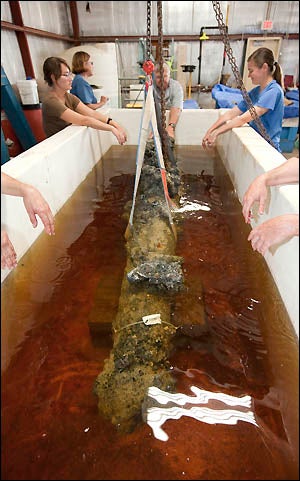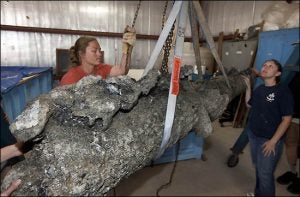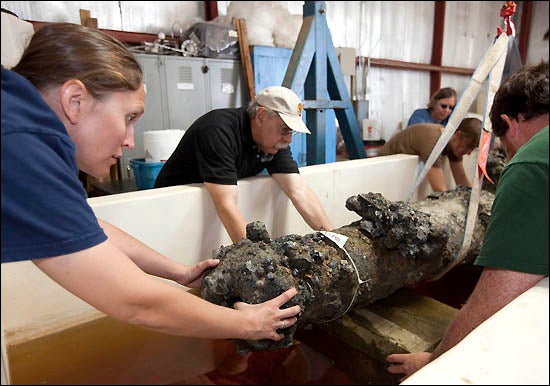QAR lab preserves Blackbeard’s treasures
A few hours after underwater archaeologists plucked one of four large anchors from the wreck of Blackbeard’s Queen Anne’s Revenge in the waters near Beaufort Inlet in May, a tourist looking at the encrusted artifact on a flatbed truck asked when it would be on display at a museum.
“Years” was the collective answer from QAR project team members standing nearby. The answer would be the same for the approximately one-ton cannon raised Wednesday from the site. The cannon arrived Thursday at the QAR Conservation Lab at East Carolina University to begin the process of being saved for future generations.
Today the large anchor sits in a 6,500-gallon tank at the QAR Conservation Lab beside hundreds of other artifacts from the shipwreck site. Similar types of artifacts are submerged in tanks filled with sodium carbonate solutions, waiting to be conserved and prepared for display in the North Carolina Maritime Museum.
The Queen Anne’s Revenge, Blackbeard’s flagship, wrecked off the North Carolina coast in 1718. Initial fieldwork at the site under the direction of the N.C. Department of Cultural Resources’ Underwater Archaeology Branch began in 1997, and it has progressed slowly and methodically.

The cannon from Blackbeard’s ship, the Queen Anne’s Revenge, rests in a holding tank at the QAR Conservation Lab at ECU.
The clock is ticking to pull artifacts from the wreckage. “We want to start bringing these pieces up off the main mound because we have a directive for three years to do full recovery as hard as we can, to get it all up. It’s about 50 percent of the site out there,” Mark Wilde-Ramsing, state underwater archaeologist, said in May as he stood by the newly hoisted anchor.
Wilde-Ramsing earned his doctorate in coastal resource management at ECU in 2009. He has directed the Queen Anne’s Revenge project since it began in 1997.
Hands-on experience
“This fall has allowed a large group of maritime studies students and professors to not just visit (the recovery site) but to also be part of the team,” said Sarah Watkins-Kenney, the QAR Lab Director and Underwater Archaeology Branch Chief Conservator with the N.C. Department of Cultural Resources.
“These students are getting hands-on experience,” during the retrieval of artifacts, Watkins-Kenney said.
Onboard the research vessels this week have been ECU graduate students in anthropology and maritime studies, undergraduate students, and Dr. Lynn Harris, QAR Intern and Independent Studies instructor with ECU Maritime Studies. Approximately 10 ECU student interns and independent study students have participated in this fall’s expedition to the Queen Anne’s Revenge recovery site.
“What we’ve been able to offer students out there, not just volunteering but also getting course credit, is exciting,” Watkins-Kenney said. “It’s a step forward for ECU. The students will get hands-on experience in the recovery of artifacts from the ocean. They will get to work on a real project instead of just seeing it in a textbook.”
ECU maritime studies students were part of the dive team, and Watkins-Kenney is hopeful that will continue for future recovery dives.
If the weather permits, the main dives at the Queen Anne’s Revenge will end this week and the site will be closed for the winter.
Two ECU graduate students –in anthropology and in maritime studies – are working in the QAR Conservation Lab currently, Watkins-Kenney said. “In addition to those students, we have ongoing research projects with ECU faculty and their students,” Watkins-Kenney said. Also undergraduate classes in history, anthropology, conservation, maritime studies, and from the Honors College visit the facility.
‘A tedious process’
In the lab, located on ECU’s West Research Campus, the work is slow but rewarding, said Shanna Daniel, Queen Anne’s Revenge project conservator.
Inside, tanks hold the anchor, as well as barrel hoops, the ship’s sternpost that was brought up in 2007, and many concretions containing glass beads, ceramics, nails and other small pieces of the ship, tools and personal items of the crew.
Here, artifacts go through a 12-step conservation process that includes documenting the artifact, cleaning, desalination, consolidation, drying and final analysis. The lab is a joint venture between the university and the N.C. Department of Cultural Resources.
“For the cleaning process, we’ll mainly be using air scribes (on the anchor),” said Daniel. These are small pneumatic air scribes and are a more controlled way to take off the layers of concretion on the artifacts, such as the cannon. Concretion, the solid mass of mineral deposits, must be removed along with the soluble salts in the metal to make the object stable to be studied, handled and displayed.
The QAR archaeologists and conservators have also used in-situ (on site) monitoring on a limited number of large artifacts while they are still on the seafloor of Beaufort Inlet. The process has the potential to shorten the desalination and stabilization time once the artifact is recovered and moved to the lab. Wendy Welsh, QAR Conservator and Lab Manager, leads those efforts.
“So actually this anchor began conservation before we ever got it in,” Daniel said.
“The main goal is not to hurt the surface of the artifact,” Daniel said, while they are removing the concretion.
“A cannon can take up to a year or more to clean so I would guess that the anchor will take at least that long,” she said.
After it’s cleaned, metal artifacts begin the electrolysis process to remove salts. “With a cannon, it could take two to three years,” Daniel said.
After electrolysis, more finite cleaning is performed before a controlled air drying with low humidity – 30 percent or less – so in eastern North Carolina that is usually done in the winter.
After the air drying, a coating of tannic acid is applied to prohibit further corrosion and to give the “aesthetic appeal” for the museum.
“When it comes out, it doesn’t look like it would in the museum. It still has that orange, rusty look,” Daniel said. Final photography and final measurements are completed before it goes to the museum.
Years to go
Chris Southerly was one of two divers in the water when the anchor and cannon came up. He and other divers used straps to secure the artifacts to lift bags that were inflated underwater to buoy them about 25 feet to the surface. Southerly, an ECU graduate, is assistant state archaeologist and one of the dive supervisors for the underwater archaeology branch.
The work in the conservation lab, Southerly said, is just as critical to preserving the archaeological treasures as the efforts underwater.
“Archaeology continues in the lab. What we take up as one object, that one object might have 50 to 100 pieces in it that have to be cleaned and stabilized,” Southerly said.
He estimated that conservation of the entire collection of QAR artifacts will take 10 to 15 years. X-rays are taken of the items once they are brought to the lab to prioritize what is conserved first, he said.
The Queen Anne’s Revenge originally was a French slave ship, La Concorde, measuring 90- to 100-feet long with three masts and a crew of 150 to 200. Blackbeard captured La Concorde in 1717 and renamed it before it ran aground in 1718 near what is today Fort Macon State Park.
Wilde-Ramsing said scientists from across the state work on the project. He singled out Cape Fear Community College and UNC-W’s research vessels and ECU’s efforts in the project. “The biggest support is from East Carolina University, which houses our conservation lab,” he said. “Nine-tenths of the work on any archaeology project is in the conservation lab.”
For more about the project, visit www.qaronline.org.

Wendy Welsh, left, QAR conservator and lab manager, and Shanna Daniel, QAR project conservator, steady the cannon as it is moved from the transport trailer to the holding tank.
